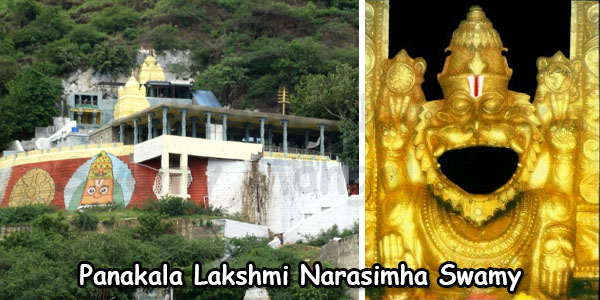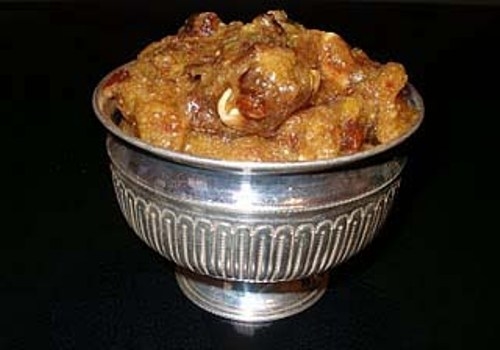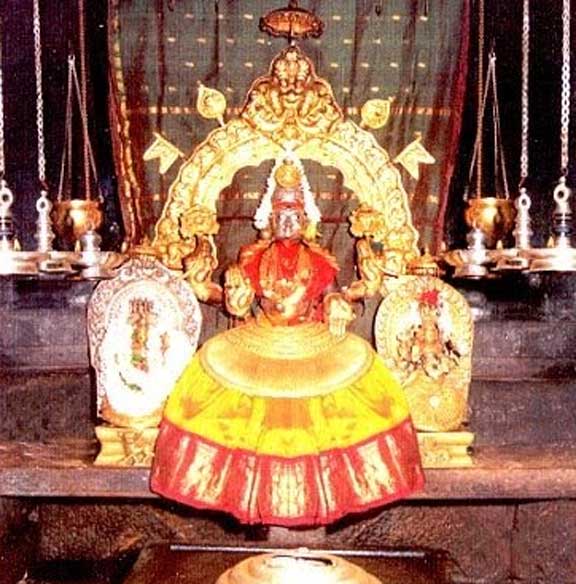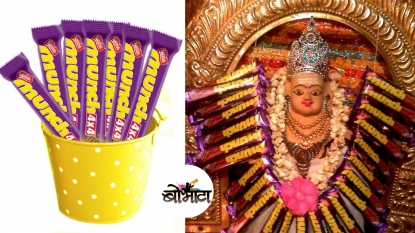Customarily food is always offered first to the Deity, be it at home or in temples. Even the smallest temple has regular puja and a naivedyam for the Deity. The prasadam typically gets distributed to those who are present at the time of the puja. Even in large and famous temples, naivedyam specially made for the puja is offered to the Deity and distributed in small quantities to the devotees present. Some of it is mixed with the prasadam made in commercial quantities to be either distributed free or sold. In addition to, or in lieu of these prasadams, Vibhuti, Kumkum, Chandan, sindoor, tulsi teerth or flowers, boondi and chironji (sugar balls) are also given in our temples.
Many of the temple prasadams have become so famous and unique that temple bhog festivals are held in five-star hotels, where prasadams from temples across the country are recreated and served to patrons!
If one were to research into how a particular naivedyam gained popularity in a particular temple, or who offered it to the Deity the very first time, it would require a volume or two to chronicle all the legends, beliefs and local lore related to them. So, I will restrict myself to just a few here.
The saltless prasadams of Oppiliyappan temple:
The Oppiliyappan temple near Kumbakonam, which is dedicated to Lord Mahavishnu, is a completely saltless premises. No salted item or even a grain of salt is allowed inside the temple complex and all the naivedyams offered are completely devoid of salt! Oppiliappan literally means ‘The peerless Lord’, though the name has got corrupted in usage to ‘Uppiliappan’ (Uppili in Tamil means ‘saltless’).
There is a sweet and heartwarming legend behind the saltless offerings.
A great sage by name of Markandeya did arduous penance to beget Lakshmi as his daughter and Lord Vishnu as his son-in-law. Pleased with his devotion, the Lord granted him the boons. And one day, Lakshmi appeared as a little girl under a tulsi plant. He named her Bhoomi Devi and brought her up with love and care. She grew into a beautiful young woman and was soon of marriageable age.
One day a very old and ailing Brahmin appeared at his doorstep. The sage welcomed and offered him hospitality. But the old man only asked for the hand of Bhoomi Devi to cook and care for him. Appalled at the thought of his beloved daughter marrying an old man, Markandeya tried to dissuade him saying that she was not only too young for him but also didn’t know how to cook – and in fact didn’t even know that one has to add salt to the food.
But the old man was adamant and said that he would be happy even with saltless food if it was cooked by her. Hearing them discuss her marriage, Bhoomi Devi threatened to commit suicide if she were forced to marry him. Sage Markandeya prayed to Lord Vishnu to bail him out of his dilemma, and lo and behold! In place of the old man stood Lord Vishnu in all his resplendent glory. Overjoyed, the sage gave his daughter’s hand to Him and asked for some boons. One of the boons was that Lord Vishnu should reside in that place, and another was that all offerings at the temple should be prepared without salt. The Lord granted him both.
And that is why even today, all prasadams including vadas, chakli, tamarind and curd rice – are prepared without salt. One can’t but wonder if Sage Markandeya had deliberately asked for this boon, knowing how harmful salt is to the human body! I guess this is another example of the wisdom of our ancestors!
Aravana Prasadam at Sabarimala:
The aravana naivedyam offered to Lord Ayyappan at Sabarimala, similarly has an interesting legend behind it. The special payasam prasadam is sent to devotees round the world.
The Deity Who ‘drinks’ panakam!
There is another unique and ancient temple in Mangalagiri in Andhra Pradesh, where the presiding Deity, Lord Narasimha ‘drinks’ the panakam (panakala/panagam), which He is offered! Panakam is flavoured palm-jaggery water, which has cooling properties. (You can get the recipe of this naivedyam here)
The temple on a hill inside a cave has no murti of the Deity, but just an opening in the rock, over which an image of the Lord’s face has been fixed, so that the opening functions as His mouth. Throughout the day litres of panakam is poured into the opening and there is a distinct gurgling sound as if someone were actually drinking the liquid.
The most astonishing thing is that no matter what the size of the vessel with the panakam – be it half a litre or five litres – only half of it would be taken in. Thereafter the drinking sound would stop and the panakam would start overflowing! Thus the remaining panakam is distributed as prasadam to the devotees. I can vouch for this miracle as I have seen it a child, when we used to visit the temple. Another astonishing phenomenon is that despite the sweet offering, some of which inevitably spills on the floor of the cave, one can’t find a single ant or fly!
Why is panakam poured into the mouth of the Lord and where does it all go? It is believed that Mangalagiri was a volcanic mountain in ancient times and the jaggery water helped to neutralise the Sulphur compounds in the rocks and prevented it from erupting. It is also believed that the ferociousness of Lord Narasimha who had become ugra (fierce) after slaying Hiranyakashipu, was effectively cooled by the panakam. The custom has continued over the eons. He is therefore known as Panakalu Narasimha by the locals. (Recipe for making panakam can be found here)
Tiruvadirai Kali:
In the month of Margashirsa (Margazhi in Tamil), falls the festival of Arudra Darshan (Ardra being the star associated with Lord Shiva). Night-long puja to Nataraja culminates in His Darshan in the early morning. The naivedyam is a sweet dish called kali, made with rice flour and jaggery. The legend of a great Shiva devotee Sendanar of Chidambaram, is associated with this naivedyam.
The story goes that, once when a mendicant came to his door on a rainy day, Sendan didn’t have anything to serve him. He offered the mendicant – who was none other than the Lord Himself – a mixture of rice flour cooked with jaggery. Pleased with his devotion, the Lord wanted his devotion to be made known to the world. So, the next morning, when the priests inexplicably found bits of Sendan’s kali on the floor of the temple, they heard the voice of the Lord telling them that the kali should be the naivedyam thenceforth.
When prasadam becomes medicine:
Some prasadams are actually infused with curative ingredients, like the panchamritam of Palani Dandayudhapani (popularly known as Palani Murugan) temple in Tamil Nadu. That is, at least till the abhishekam was done to the original murti made of nava pashanam, which literally means nine poisonous substances/minerals.
Tamil Nadu has been home to scores of saints who had attained Siddhi in various disciplines including herbal medicines and alchemy. One of them, Siddhar Bogar carefully selected and combined over 4000 herbs to create the nava pashanam mixture, which has tremendous healing properties. With this, he sculpted the murti of Murugan, which he established in Palani. When abhishekam is performed on the murti with milk or panchamritam, they absorb the healing ingredients in the right quantity and help free people from all diseases and ills. A scientist’s perspective about the Palani Murugan murti can be read here.
There are also some temples which give herbal medicine as prasadam. These are made of local ingredients and actually have curative powers.
Kashaya Prasadam at Mookambika temple:
The Mookambika temple at Kollur has an unusual naivedyam – a herbal concoction called kashayam (kadha) offered to the goddess after the night puja. The much sought-after kashayam is believed to cure diseases.
The custom had started after Adi Sankara had been given a herbal kashayam prepared by Devi Mookambika herself to cure him, when he had fallen ill during his visit to the temple.
The Marundhu (medicine) of Vaitheeswaran temple:
The Vaitheeswaran temple near Kumbakonam is another one, that has marundhu or medicine as prasadam. Tiny pellets are made of the mineral-rich clay from a pond nearby and mixed with the essence of neem leaves, neem-bark powder and vibhuti, to make this prasadam.
Many temples in Kerala have herbal medicines as prasadam too.
As I mentioned earlier, naivedyam need not be elaborate or special. Lord Krishna says in the Bhagavad Gita (9.26):
पत्रं पुष्पं फलं तोयं यो मे भक्त्या प्रयच्छति |
तदहं भक्त्युपहृतमश्नामि प्रयतात्मन:
“If one offers Me with love and devotion a leaf, a flower, fruit, or water, I will accept it.” He says, “I accept the bhakti.”
Despite those who mock our customs and the very religion, the fact is that Hinduism has adapted itself to the mores of changing times and lifestyles over the ages. Our customs and even traditions are constantly evolving. Is there any wonder then, naivedyams have undergone changes too? Here are a couple of unusual of naivedyams:
Munch Murugan
• There is a Bala Murugan (Baby Subrahmanya) temple in Kerala, where the Lord is offered Nestle Munch chocolates! He even wears a garland made of the said chocolates. This custom is very recent and has come under the mocking lens of many.
Apparently, about seven years ago, a young devotee offered his favourite child God some Munch chocolates and had had his wish fulfilled. The tale spread and others started offering Munch chocolates too. Soon, the Deity got nicknamed ‘Munch Murugan’!
Noodles for Kali!
• The Goddess at the Kali temple in a predominantly Chinese locality of Kolkata is offered a naivedyam of noodles and momos!
These are just some of the temple prasadams with interesting stories behind them. It is by no means an exhaustive article as there are many unusual prasadams, both edible and non-edible, that are given to devotees in many temples across the country. All one can say is that whatever be the prasadam, it should be taken with reverence and faith by the devotees. After all, one of the most important curative and palliative components of a prasadam, is Faith, isn’t it?
……3
(Read the first part: Naivedyam I – Offering with love and surrender)
A version of this post was first published in Jagrit Bharat.
Images: Top: http://lemoninginger.com














We had visited many temples in India but Uppilappan still evades us. Must try again! Thanks for writing the story about why salt is not added in prasadams here.
Panakala Lakshmi story also is interesting!
Noodles as naivedhyam! Incredible.
Enjoyed reading this post too, Zephyr…Thank you!
LikeLike
I really enjoyed eating all the prasadams at Oppiliyappan koil. One doesn’t notice the lack of salt at all. It is incredible! Next time you visit Andhra, you must go to Mangalagiri. It is an unforgettable experience. They say that one can visit a temple only if the Deity calls to us. We lived for 20 years in Delhi but never could visit Vaishno Devi. And She has still not called us!
LikeLike
That is an interesting article.Barring the story of saltfree Oppiliappan prasad, the rest are all new to me. I could see a lot of research has gone into the preparation of this informative post with a sharp eye for details
I salute you.
LikeLike
Thanks a lot for noticing the efforts that had gone into the making of this series. Sifting through information, one has to make sure that the info is from credible sources. That combines with personal experience and family tales helped me in writing them. Glad you liked the series.
LikeLike